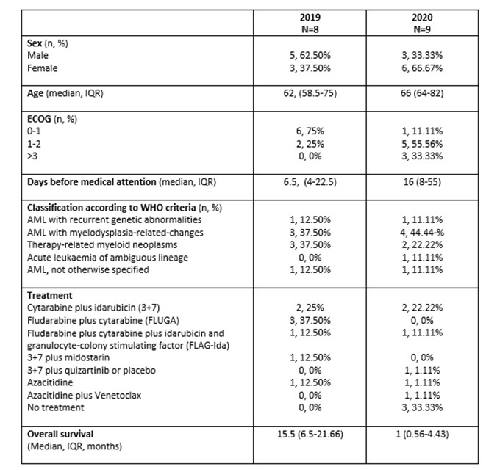
Contributions
Abstract: EP492
Type: E-Poster Presentation
Session title: Acute myeloid leukemia - Clinical
Background
Since the first case of severe acute respiratory infection by coronavirus 2 (SARS-CoV-2), Coronavirus Disease 2019 (COVID-19) has been the priority in any centre. This situation has produced collateral damage in patients with other acute diseases, with a delay in diagnosis and associated poorer outcomes. Acute myeloid leukemia (AML) is considered a hematologic emergency and delayed induction chemotherapy can harm these patients.
Aims
To analyse the impact of the COVID-19 epidemic outbreak on patients diagnosed with AML. We examined the impact on the times from symptom onset to hospital admission, performance status, possibility of administrating treatment and short-term outcome.
Methods
Patients diagnosed with AML between January 1, 2019 and December 31, 2020 were included. Cases were grouped into two periods, depending on the year. Demographic and clinical data were recorded including age, sex, detection of symptoms to diagnosis, Eastern Cooperative Oncology Group (ECOG) performance status, diagnoses using World Health Organization (WHO) classification, treatment administered, overall survival, and mortality. Comparisons between groups were made using chi-square tests to compare categorical variables and the Student test for continuous variables; with Kaplan-Meier estimates and Log-Rank test for survival analysis.
Results
In total 17 patients with AML were studied (male 9; 52.94%; median age 66; interquartile range (IQR) 59-74). Table 1 shows the comparison of baseline characteristics of the patients between the two years. In 2020 there was an increase in the time until the admission to the hospital (30.55 days vs 11.55 days, p=0.0419), with a worsening in ECOG punctuation on arrival statistically significant (Xi2=7.8254, p=0.020). In 2019, all the patients received treatment; and in 2020, 3 patients due to their status; did not received treatment, just best supportive care. Overall survival time was inferior in the cohort of 2020 (3.064 vs 14.028 months; p=0.045).

Conclusion
This retrospective study realized in our centre illustrates the collateral damage caused by the COVID-19 pandemic. Delay in seeking medical attention in a time-course-dependent pathology such as AML; it is followed by an increase in morbidity and mortality.
Keyword(s): COVID-19, Diagnosis, Leukemia
Abstract: EP492
Type: E-Poster Presentation
Session title: Acute myeloid leukemia - Clinical
Background
Since the first case of severe acute respiratory infection by coronavirus 2 (SARS-CoV-2), Coronavirus Disease 2019 (COVID-19) has been the priority in any centre. This situation has produced collateral damage in patients with other acute diseases, with a delay in diagnosis and associated poorer outcomes. Acute myeloid leukemia (AML) is considered a hematologic emergency and delayed induction chemotherapy can harm these patients.
Aims
To analyse the impact of the COVID-19 epidemic outbreak on patients diagnosed with AML. We examined the impact on the times from symptom onset to hospital admission, performance status, possibility of administrating treatment and short-term outcome.
Methods
Patients diagnosed with AML between January 1, 2019 and December 31, 2020 were included. Cases were grouped into two periods, depending on the year. Demographic and clinical data were recorded including age, sex, detection of symptoms to diagnosis, Eastern Cooperative Oncology Group (ECOG) performance status, diagnoses using World Health Organization (WHO) classification, treatment administered, overall survival, and mortality. Comparisons between groups were made using chi-square tests to compare categorical variables and the Student test for continuous variables; with Kaplan-Meier estimates and Log-Rank test for survival analysis.
Results
In total 17 patients with AML were studied (male 9; 52.94%; median age 66; interquartile range (IQR) 59-74). Table 1 shows the comparison of baseline characteristics of the patients between the two years. In 2020 there was an increase in the time until the admission to the hospital (30.55 days vs 11.55 days, p=0.0419), with a worsening in ECOG punctuation on arrival statistically significant (Xi2=7.8254, p=0.020). In 2019, all the patients received treatment; and in 2020, 3 patients due to their status; did not received treatment, just best supportive care. Overall survival time was inferior in the cohort of 2020 (3.064 vs 14.028 months; p=0.045).

Conclusion
This retrospective study realized in our centre illustrates the collateral damage caused by the COVID-19 pandemic. Delay in seeking medical attention in a time-course-dependent pathology such as AML; it is followed by an increase in morbidity and mortality.
Keyword(s): COVID-19, Diagnosis, Leukemia


